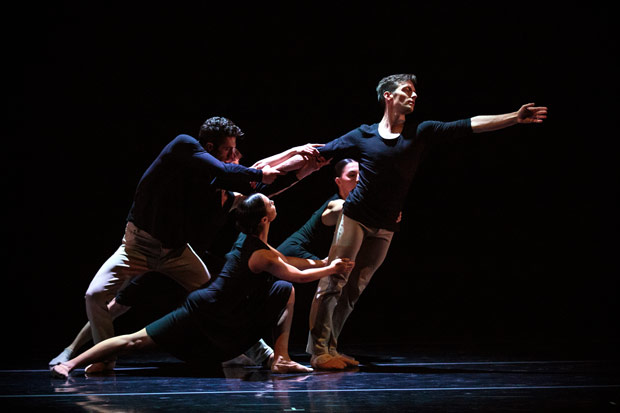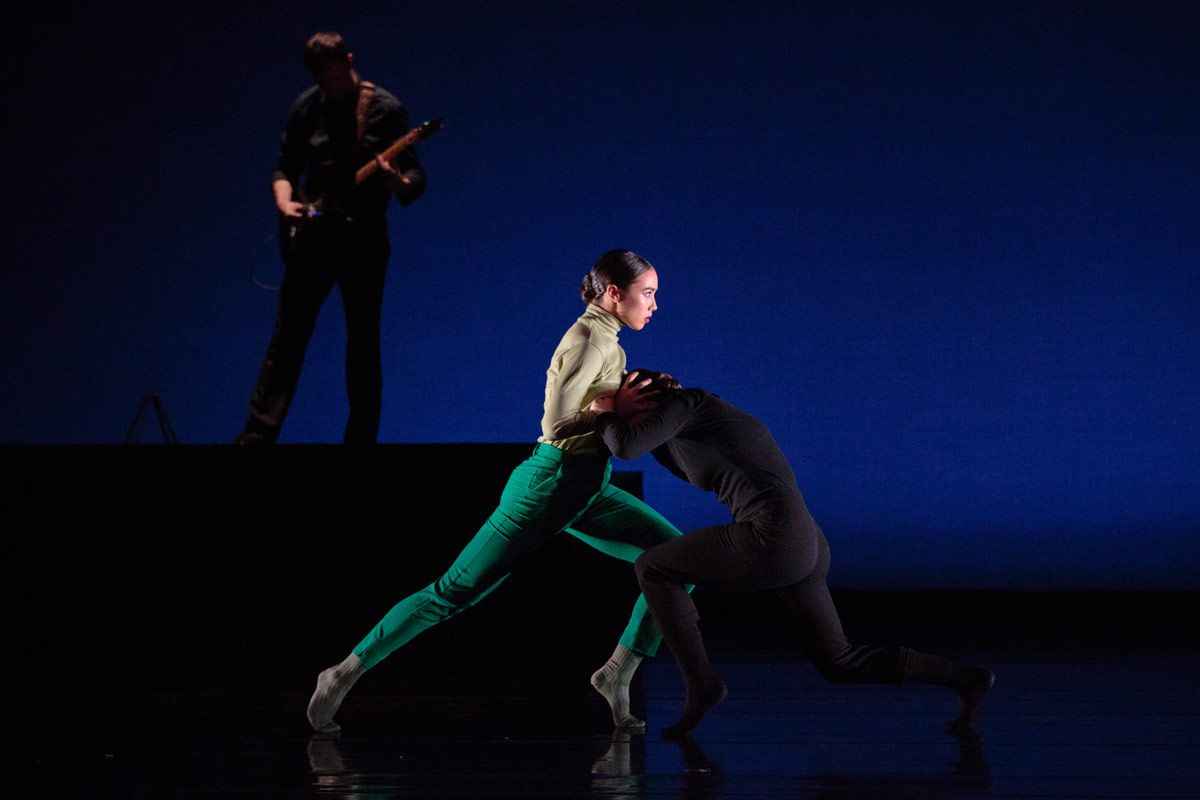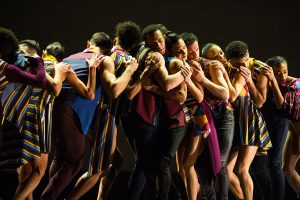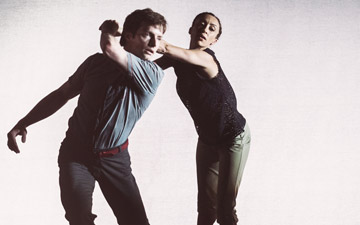
© Alexander Reneff-Olson. (Click image for larger version)
SFDanceworks
Season Three: Snap, Homing, The Old Child, Jardí Tancat
★★★★✰
San Francisco, Cowell Theater
9 June 2018
www.sfdanceworks.org
fortmason.org
SFDanceworks is going places. Formed in 2014 by longtime San Francisco Ballet soloist James Sofranko, the relatively new company already finds itself in a season of expansion. Their creative team has grown with the recent appointment of Danielle Rowe as Associate Artistic Director (Sofranko will be pulling double duty as Artistic Director at Grand Rapids Ballet while continuing to lead SFDanceworks). They moved from ODC Theater to Cowell Theater at Fort Mason to accommodate a larger audience. And their broad repertory – classical and contemporary; new premieres and iconic works – is deepening with every passing year. This past weekend, SFDanceworks welcomed audiences to its third home season and those who were present can surely attest to why the troupe is in this state of expansion. SFDanceworks is good. Actually no, it’s really good.
In the program’s welcome, Sofranko reiterated SFDanceworks’ vision to present work from the “past, present, and future…” In Saturday night’s show, this conversation across time came in the form of a quadruple bill: Penny Saunders’ Snap, Nacho Duato’s Jardí Tancat and the world premieres of Sofranko’s Homing and Rowe’s The Old Child. It was a strong program, both choreographically and in the performances by the dancers. Not every company has both sides of this equation; it’s one of the reasons why SFDanceworks is so special.

© Alexander Reneff-Olson. (Click image for larger version)
The evening kicked off with the shortest piece on the program, Saunders’ Snap, created in 2016 for Hubbard Street Dance Chicago. A duet, danced at this performance by Rowe and Brett Conway, Snap challenges its audience to consider resolution and completeness. The dimly lit stage (design by Jim French) beckoned Rowe and Conway into the space. Entering from opposite sides, they met in the middle and started a series of gestural hand motions, a clapping game. As the clapping concluded and the duet moved on, it was clear that a game was still afoot, though this was no schoolyard scene. The mood was mysterious and flirtatious. And I kind of assumed that if there was to be a competition, Rowe and Conway would be the players. But Saunders crafted something much more nuanced and clever. Rowe and Conway launched into a series of partnering sequences – supported arabesques slid across the stage, weight shifts and counterbalances unfolded in close proximity. As each of Snap’s phrases played out, I waited for the conclusion, that natural moment of repose as a movement phrase ends. That moment would remain elusive. Instead, Rowe and Conway would separate mid-phrase. Then the cycle would repeat, over and over again; the phrases left open and undone. Like someone was singing a familiar song and then deciding to stop the lyrics before the last line. Snap’s game was with its audience, confronting what viewers might expect from dance and choreography. What if the ending you yearn for doesn’t materialize? Does incompleteness necessarily mean unfulfilled?
Elements of surprise and interruption also factored heavily in Sofranko’s Homing, a quintet set to Schubert, well interpreted by pianist Ronny Michael Greenberg. Schubert’s music has a profound effect on me, in part because it is surprising and unexpected. A soothing, lyrical motif can suddenly pivot to a jarring, dissonant pattern. Repeated ethereal chords contribute an ambivalence and uncertainty. You think you’re solidly rooted in one major key, only to be quickly jolted into a minor, seemingly out of nowhere. The music is ever changing and complex; an apt choice for Sofranko’s Homing, a ballet that similarly shifted and morphed.
Three women and two men gathered in a tableau center stage, encased by a soft glowing pool of light (again by French). As the music began, expressionless, they started to re-organize themselves: pushing in front of each other, reaching arms and legs out to the edges of the stage, trying to alter their set arrangement. They seemed eager (and maybe a little desperate) to see what was beyond; beyond this point in space, beyond this group of five. Homing afforded them that opportunity. In a subsequent collection of duets and solos, the quintet explored the space, though the freedom wasn’t absolute. In keeping with Homing’s initial reorganization theme, Sofranko skillfully choreographed an interruption for each vignette (also reflective of how Schubert’s music is constantly interrupted by something new and different). As the dancers covered the stage in a winning choreographic blend of vast extensions, traveling steps and subtle drag turns, a new dancer would enter and the scene would adjust and change. But they didn’t appear annoyed at the interruption, instead, seeing it as another chance to experiment outside of parameters, to experience a different configuration. At the end of Homing, the five returned to their original center grouping. Their expressions had drastically shifted and contentment pervaded the space. They seemed happy to have had the chance to explore and roam, and also happy to be back together.

© Alexander Reneff-Olson. (Click image for larger version)
Ambient, amplified guitar chords rang through the air even before the lights dimmed for Rowe’s The Old Child, an ensemble dance for eight. Over its twenty minutes, the piece would time warp from place to place, a movement collage of different moments in one human journey. Scoring all these remembrances was Alton San Giovanni’s original composition, recorded and then layered with live guitar played by David Knight.
Britt Juleen spent the majority of the dance downstage right, in a child’s pose facing the back (definitely a propos considering the dance’s title). Throughout Child, she would slowly rise to standing, and with a trembling hand and arm, summon each new choreographic sequence. Then she would return to that child’s pose until it was time for the next episode from her past. With its sprightly jumps and cradling motifs, Anne Zivolich-Adams and Garrett Anderson’s duet was all about sweet affection and joyful buoyancy. Determined and intense strides informed another chapter, danced by Dana Genshaft and Katerina Eng. With hands splayed like talons and long running steps, they systematically clawed their way forward. A recurring waving gesture in Nicholas Korkos’ solo felt like a loss, maybe a significant someone who had left Juleen’s story. And then, Juleen rose for one of the final episodes, this time, her head vigorously shaking ‘no’. She looked terrified. And so, I was prepped for something ominous, disturbing, maybe even treacherous. What followed was not what I expected (though it was impeccably danced by Laura O’Malley and Conway). There were some instances of Conway manipulating O’Malley’s limbs, but overall, the choreography for this duet felt oddly subdued. And while I thoroughly enjoyed the score, it more or less stayed at the same dynamic level, which again felt a curious match to the range of emotions and tones in Child.

© Alexander Reneff-Olson. (Click image for larger version)
The final work on the program was Duato’s Jardí Tancat, a dance for six (three women, three men) originally composed for Nederlands Dans Theater in 1983. Set to the folk vocals of Maria del Mar Bonet, an agrarian community is the focus of this spectacular dance. Its choreography is clear and succinct, evocative and thoughtful – a brilliant conclusion to SFDanceworks third home season.
There was much to love in Jardí Tancat. Percussive footwork patterns were danced with fire and brio. With arms curved like scythes, diving to the floor in a reaping motion, the mens trio was imbued with gestures of harvest and cultivation. Movements staggered in canon rippled through the space like wind blowing through crops. The cast surveyed the horizon in hopeful wonder. And I was so pulled to Duato’s use of flexion in the choreography – both in the feet and in the hands. Flexed feet are certainly evident in many folk-dance traditions. But here, the flexion of the feet and hands seemed to make a deeper comment. Exposed soles and palms emphasized the toil that the feet and hands undertake. And the flexed hands also brought to mind a prayerful posture; the palms reaching out in offering to the heavens; maybe a thanksgiving, maybe a lament, maybe a combination of the two.

















You must be logged in to post a comment.